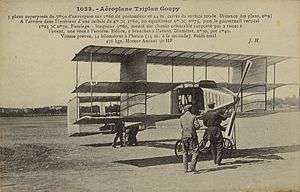Goupy No.1
| No.1 | |
|---|---|
 | |
| Role | Experimental aircraft |
| National origin | France |
| Manufacturer | Voisin |
| First flight | 5 September 1908 |
| Number built | 1 |
|
| |
The Goupy No.1, a.k.a. Goupy I bis was an experimental aircraft built in France during 1908, which on 5 September that year became the first French triplane to fly. It was designed by Ambroise Goupy and built by Aéroplanes Voisin. Unlike previous aircraft built by Voisin, which had been pusher biplanes with a front elevator, the Goupy No.1 was a tractor triplane, with the ends of the wings connected by Voisin's characteristic "side curtains". The tailplane was a Hargrave cell in line with contemporary Voisin practice, with the addition of a pair of small moving elevators mounted on the leading edge of the outer surfaces and a central rudder. The undercarriage consisted of a single wheel mounted below the wing and a tailwheel.[1] As originally constructed, the middle wing was mounted in a mid-wing position on the fuselage, with the top and bottom wings clear of the fuselage, and power was provided by an Antoinette engine. The design was later revised so that the bottom wing was mounted at the base of the fuselage, the middle wing to the top of the fuselage, and top wings clear of it. At the same time, the engine was changed to an Anzani of similar power and the wings extended outboard of the side curtains, and the single central mainwheel replaced by a pair of wheels.
Specifications
General characteristics
- Crew: One pilot
- Length: 9.80 m (32 ft 2 in)
- Wingspan: 7.50 m (24 ft 7 in)
- Wing area: 44.0 m2 (474 ft2)
- Gross weight: 476 kg (1,050 lb)
- Powerplant: 1 × Anzani, 37 kW (50 hp) each
Performance
- Maximum speed: 54 km/h (33 mph)
References
- ↑ The Goupy Triplane Flight magazine 30 January 1909]
- Taylor, Michael J. H. (1989). Jane's Encyclopedia of Aviation. London: Studio Editions. p. 429.
- "The Goupy Triplane". Flight: 65. 3 January 1909. Retrieved 2008-04-09.